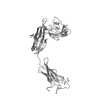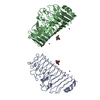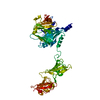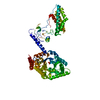+ Open data
Open data
- Basic information
Basic information
| Entry | Database: PDB / ID: 1igr | |||||||||
|---|---|---|---|---|---|---|---|---|---|---|
| Title | Type 1 Insulin-like growth factor receptor (DOMAINS 1-3) | |||||||||
 Components Components | INSULIN-LIKE GROWTH FACTOR RECEPTOR 1 | |||||||||
 Keywords Keywords | HORMONE RECEPTOR / INSULIN RECEPTOR FAMILY | |||||||||
| Function / homology |  Function and homology information Function and homology informationprotein kinase complex / insulin-like growth factor receptor activity / insulin-like growth factor binding / Signaling by Type 1 Insulin-like Growth Factor 1 Receptor (IGF1R) / protein transporter activity / IRS-related events triggered by IGF1R / transcytosis / insulin receptor complex / insulin-like growth factor I binding / positive regulation of protein-containing complex disassembly ...protein kinase complex / insulin-like growth factor receptor activity / insulin-like growth factor binding / Signaling by Type 1 Insulin-like Growth Factor 1 Receptor (IGF1R) / protein transporter activity / IRS-related events triggered by IGF1R / transcytosis / insulin receptor complex / insulin-like growth factor I binding / positive regulation of protein-containing complex disassembly / insulin receptor activity / alphav-beta3 integrin-IGF-1-IGF1R complex / regulation of JNK cascade / dendritic spine maintenance / peptidyl-tyrosine autophosphorylation / insulin binding / amyloid-beta clearance / Respiratory syncytial virus (RSV) attachment and entry / insulin receptor substrate binding / SHC-related events triggered by IGF1R / phosphatidylinositol 3-kinase binding / negative regulation of MAPK cascade / insulin-like growth factor receptor signaling pathway / insulin receptor binding / cellular response to glucose stimulus / phosphatidylinositol 3-kinase/protein kinase B signal transduction / receptor protein-tyrosine kinase / cellular response to amyloid-beta / insulin receptor signaling pathway / positive regulation of cold-induced thermogenesis / protein autophosphorylation / protein tyrosine kinase activity / Extra-nuclear estrogen signaling / positive regulation of phosphatidylinositol 3-kinase/protein kinase B signal transduction / receptor complex / positive regulation of MAPK cascade / immune response / cilium / positive regulation of cell migration / axon / intracellular membrane-bounded organelle / positive regulation of cell population proliferation / negative regulation of apoptotic process / nucleolus / signal transduction / ATP binding / identical protein binding / membrane / plasma membrane Similarity search - Function | |||||||||
| Biological species |  Homo sapiens (human) Homo sapiens (human) | |||||||||
| Method |  X-RAY DIFFRACTION / X-RAY DIFFRACTION /  MIRAS / Resolution: 2.6 Å MIRAS / Resolution: 2.6 Å | |||||||||
 Authors Authors | Garrett, T.P.J. / Mckern, N.M. / Lou, M. / Frenkel, M.J. / Bentley, J.D. / Lovrecz, G.O. / Elleman, T.C. / Cosgrove, L.J. / Ward, C.W. | |||||||||
 Citation Citation |  Journal: Nature / Year: 1998 Journal: Nature / Year: 1998Title: Crystal structure of the first three domains of the type-1 insulin-like growth factor receptor. Authors: Garrett, T.P. / McKern, N.M. / Lou, M. / Frenkel, M.J. / Bentley, J.D. / Lovrecz, G.O. / Elleman, T.C. / Cosgrove, L.J. / Ward, C.W. #1:  Journal: Protein Sci. / Year: 1997 Journal: Protein Sci. / Year: 1997Title: Crystallization of the First Three Domains of the Human Insulin-Like Growth Factor-1 Receptor Authors: Mckern, N.M. / Lou, M. / Frenkel, M.J. / Verkuylen, A. / Bentley, J.D. / Lovrecz, G.O. / Ivancic, N. / Elleman, T.C. / Garrett, T.P.J. / Cosgrove, L.J. / Ward, C.W. | |||||||||
| History |
|
- Structure visualization
Structure visualization
| Structure viewer | Molecule:  Molmil Molmil Jmol/JSmol Jmol/JSmol |
|---|
- Downloads & links
Downloads & links
- Download
Download
| PDBx/mmCIF format |  1igr.cif.gz 1igr.cif.gz | 114.6 KB | Display |  PDBx/mmCIF format PDBx/mmCIF format |
|---|---|---|---|---|
| PDB format |  pdb1igr.ent.gz pdb1igr.ent.gz | 86.8 KB | Display |  PDB format PDB format |
| PDBx/mmJSON format |  1igr.json.gz 1igr.json.gz | Tree view |  PDBx/mmJSON format PDBx/mmJSON format | |
| Others |  Other downloads Other downloads |
-Validation report
| Summary document |  1igr_validation.pdf.gz 1igr_validation.pdf.gz | 557 KB | Display |  wwPDB validaton report wwPDB validaton report |
|---|---|---|---|---|
| Full document |  1igr_full_validation.pdf.gz 1igr_full_validation.pdf.gz | 599.4 KB | Display | |
| Data in XML |  1igr_validation.xml.gz 1igr_validation.xml.gz | 17.2 KB | Display | |
| Data in CIF |  1igr_validation.cif.gz 1igr_validation.cif.gz | 24.5 KB | Display | |
| Arichive directory |  https://data.pdbj.org/pub/pdb/validation_reports/ig/1igr https://data.pdbj.org/pub/pdb/validation_reports/ig/1igr ftp://data.pdbj.org/pub/pdb/validation_reports/ig/1igr ftp://data.pdbj.org/pub/pdb/validation_reports/ig/1igr | HTTPS FTP |
-Related structure data
| Similar structure data |
|---|
- Links
Links
- Assembly
Assembly
| Deposited unit | 
| ||||||||
|---|---|---|---|---|---|---|---|---|---|
| 1 |
| ||||||||
| Unit cell |
|
- Components
Components
-Protein , 1 types, 1 molecules A
| #1: Protein | Mass: 54393.746 Da / Num. of mol.: 1 / Fragment: UNP residues 31-492 Source method: isolated from a genetically manipulated source Source: (gene. exp.)  Homo sapiens (human) Homo sapiens (human)Description: LARGE SCALE CELL CULTURE IN A CELLGEN PLUS BIOREACTOR Cellular location: CYTOPLASMIC MEMBRANE / Organ: PLACENTA / Plasmid: PEE14/IGF-1R/462 / Cell line (production host): LEC8 / Cellular location (production host): SECRETED / Culture collection (production host): CRL:1737 / Production host:  References: UniProt: P08069, receptor protein-tyrosine kinase |
|---|
-Sugars , 3 types, 4 molecules 
| #2: Polysaccharide | 2-acetamido-2-deoxy-beta-D-glucopyranose-(1-4)-[alpha-L-fucopyranose-(1-6)]2-acetamido-2-deoxy-beta- ...2-acetamido-2-deoxy-beta-D-glucopyranose-(1-4)-[alpha-L-fucopyranose-(1-6)]2-acetamido-2-deoxy-beta-D-glucopyranose Source method: isolated from a genetically manipulated source |
|---|---|
| #3: Polysaccharide | alpha-D-mannopyranose-(1-3)-beta-D-mannopyranose-(1-4)-2-acetamido-2-deoxy-beta-D-glucopyranose-(1- ...alpha-D-mannopyranose-(1-3)-beta-D-mannopyranose-(1-4)-2-acetamido-2-deoxy-beta-D-glucopyranose-(1-4)-[alpha-L-fucopyranose-(1-6)]2-acetamido-2-deoxy-beta-D-glucopyranose Source method: isolated from a genetically manipulated source |
| #4: Sugar |
-Non-polymers , 2 types, 56 molecules 


| #5: Chemical | ChemComp-SO4 / #6: Water | ChemComp-HOH / | |
|---|
-Details
| Has protein modification | Y |
|---|
-Experimental details
-Experiment
| Experiment | Method:  X-RAY DIFFRACTION / Number of used crystals: 1 X-RAY DIFFRACTION / Number of used crystals: 1 |
|---|
- Sample preparation
Sample preparation
| Crystal | Density Matthews: 4.27 Å3/Da / Density % sol: 66 % | ||||||||||||||||||||
|---|---|---|---|---|---|---|---|---|---|---|---|---|---|---|---|---|---|---|---|---|---|
| Crystal grow | pH: 7.5 Details: PROTEIN WAS CRYSTALLIZED FROM 2.0 M AMMONIUM SULFATE, 100 MM HEPES, PH 7.5 | ||||||||||||||||||||
| Crystal | *PLUS | ||||||||||||||||||||
| Crystal grow | *PLUS pH: 8 / Method: vapor diffusion, hanging drop / Details: Mckern, N.M., (1997) Protein Sci., 6, 2663. | ||||||||||||||||||||
| Components of the solutions | *PLUS
|
-Data collection
| Diffraction | Mean temperature: 103 K |
|---|---|
| Diffraction source | Source:  ROTATING ANODE / Type: MACSCIENCE M18X / Wavelength: 1.5418 ROTATING ANODE / Type: MACSCIENCE M18X / Wavelength: 1.5418 |
| Detector | Type: RIGAKU RAXIS IV / Detector: IMAGE PLATE / Date: Nov 15, 1996 / Details: MIRRORS |
| Radiation | Monochromator: NI FILTER / Protocol: SINGLE WAVELENGTH / Monochromatic (M) / Laue (L): M / Scattering type: x-ray |
| Radiation wavelength | Wavelength: 1.5418 Å / Relative weight: 1 |
| Reflection | Resolution: 2.6→15 Å / Num. obs: 26963 / % possible obs: 99.6 % / Observed criterion σ(I): 0 / Redundancy: 4.1 % / Rmerge(I) obs: 0.064 / Net I/σ(I): 18.7 |
| Reflection shell | Resolution: 2.6→2.69 Å / Redundancy: 3.8 % / Rmerge(I) obs: 0.519 / Mean I/σ(I) obs: 3.3 / % possible all: 97.4 |
- Processing
Processing
| Software |
| ||||||||||||||||||||||||||||||||||||||||||||||||||||||||||||||||||||||||||||||||||||
|---|---|---|---|---|---|---|---|---|---|---|---|---|---|---|---|---|---|---|---|---|---|---|---|---|---|---|---|---|---|---|---|---|---|---|---|---|---|---|---|---|---|---|---|---|---|---|---|---|---|---|---|---|---|---|---|---|---|---|---|---|---|---|---|---|---|---|---|---|---|---|---|---|---|---|---|---|---|---|---|---|---|---|---|---|---|
| Refinement | Method to determine structure:  MIRAS / Resolution: 2.6→7 Å / Cross valid method: THROUGHOUT / σ(F): 2 MIRAS / Resolution: 2.6→7 Å / Cross valid method: THROUGHOUT / σ(F): 2 Details: PLANAR RESTRAIN FOR PEPTIDES, RMS=0.0384, SIGMA=0.04, AROMATIC PLANES RMS= 0.0097, SIGMA=0.015 POSITIONS OF ATOMS WITH B GREATER THAN 75 ARE NOT RELIABLE. ATOMS HAVE BEEN GIVEN OCCUPANCY OF ...Details: PLANAR RESTRAIN FOR PEPTIDES, RMS=0.0384, SIGMA=0.04, AROMATIC PLANES RMS= 0.0097, SIGMA=0.015 POSITIONS OF ATOMS WITH B GREATER THAN 75 ARE NOT RELIABLE. ATOMS HAVE BEEN GIVEN OCCUPANCY OF 0.01 OR OMITTED IF NO ELECTRON DENSITY WAS OBSERVED. FOR RESIDUES 457-459 THE DENSITY WAS NOTABLY WEAKER THAN THE ADJACENT RESIDUES. THIS SECTION HAS BEEN INCLUDED WITH OCCUPANCY OF 0.5
| ||||||||||||||||||||||||||||||||||||||||||||||||||||||||||||||||||||||||||||||||||||
| Displacement parameters | Biso mean: 52.3 Å2
| ||||||||||||||||||||||||||||||||||||||||||||||||||||||||||||||||||||||||||||||||||||
| Refinement step | Cycle: LAST / Resolution: 2.6→7 Å
| ||||||||||||||||||||||||||||||||||||||||||||||||||||||||||||||||||||||||||||||||||||
| Refine LS restraints |
| ||||||||||||||||||||||||||||||||||||||||||||||||||||||||||||||||||||||||||||||||||||
| Software | *PLUS Name: REFMAC / Classification: refinement | ||||||||||||||||||||||||||||||||||||||||||||||||||||||||||||||||||||||||||||||||||||
| Refinement | *PLUS Highest resolution: 2.6 Å / σ(F): 2 / % reflection Rfree: 10 % / Rfactor obs: 0.237 | ||||||||||||||||||||||||||||||||||||||||||||||||||||||||||||||||||||||||||||||||||||
| Solvent computation | *PLUS | ||||||||||||||||||||||||||||||||||||||||||||||||||||||||||||||||||||||||||||||||||||
| Displacement parameters | *PLUS Biso mean: 52.3 Å2 | ||||||||||||||||||||||||||||||||||||||||||||||||||||||||||||||||||||||||||||||||||||
| Refine LS restraints | *PLUS Type: p_plane_restr / Dev ideal target: 0.04 |
 Movie
Movie Controller
Controller











 PDBj
PDBj








